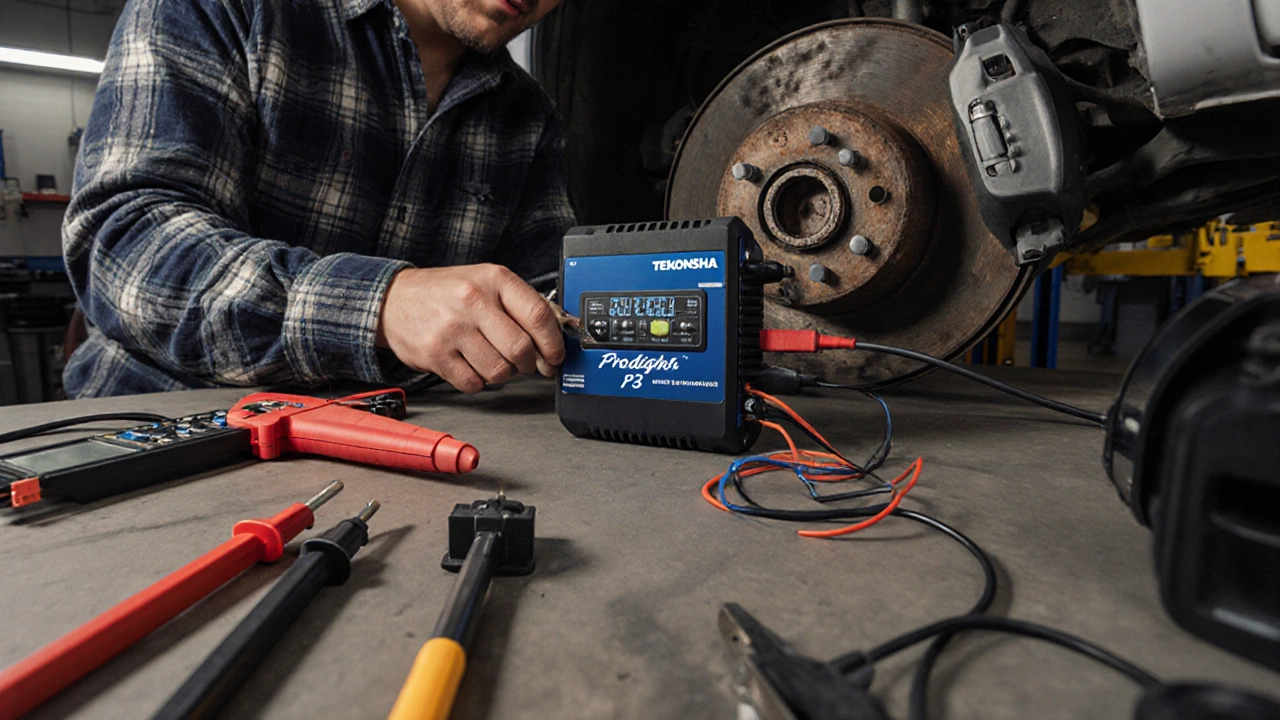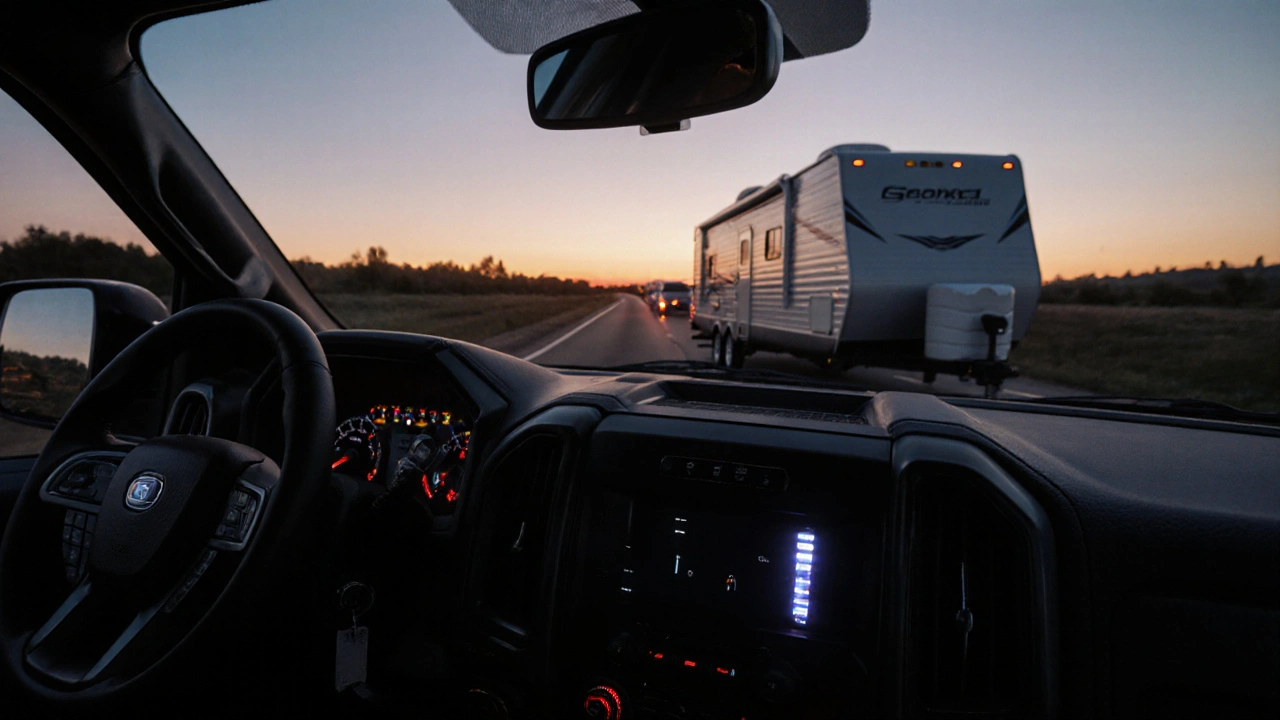When you're hauling a trailer behind your pickup truck, stopping isn't just about pressing the brake pedal. If your trailer doesn't stop at the same time and with the same force as your truck, you're risking a jackknife, sway, or worse - a serious accident. That's where a brake controller comes in. It's not a luxury. It's the difference between a smooth stop and a disaster.
Why Your Pickup Truck Needs a Brake Controller
Most trailers weighing over 1,500 pounds require their own braking system. But those brakes don’t work on their own. They need to sync with your truck’s brakes. Without a brake controller, your trailer either doesn’t brake at all or brakes randomly - which can pull your truck sideways or cause the trailer to slam into the back of your rig.
Truck manufacturers don’t install brake controllers by default. Even if your truck has a factory tow package, it’s usually just the wiring harness. The controller is still missing. You have to add it. And if you’re towing a travel trailer, boat trailer, utility trailer, or horse trailer, skipping this step is like driving without seatbelts.
According to the National Highway Traffic Safety Administration, trailer-related crashes increased by 18% between 2019 and 2023. Nearly 40% of those involved improper or missing trailer braking systems. A properly installed brake controller cuts your risk of a trailer-related accident by more than half.
How Brake Controllers Work
A brake controller is a small electronic box, usually mounted under your dashboard. It connects to your truck’s brake system and sends a signal to your trailer’s electric brakes when you press the pedal.
There are two main types: time-delayed and proportional.
Time-delayed controllers apply trailer brakes after a fixed delay once you hit your truck’s brakes. They’re cheaper and easier to install, but they don’t adjust to how hard you’re braking. If you brake gently, the trailer brakes too late. If you brake hard, the trailer might lock up. This type works okay for light trailers under 3,000 pounds, but it’s not ideal for heavier loads.
Proportional controllers are smarter. They use sensors to detect how fast your truck is slowing down - and apply trailer brakes with the same intensity. If you tap the brakes for a slow stop, the trailer brakes gently. If you stomp on the pedal during an emergency, the trailer brakes hard, in sync. This is the kind professional haulers and serious campers use.
Proportional controllers respond in milliseconds. They read your truck’s deceleration rate - how quickly you’re losing speed - and match it exactly. That’s why they’re called proportional. It’s physics in action: equal force, equal stopping power.
Types of Trailer Brakes
Not all trailers have the same brakes. Your brake controller must match your trailer’s braking system.
- Electric drum brakes: Most common on smaller trailers. They use an electromagnet to press brake shoes against a drum. These require a standard electric brake controller.
- Electric over hydraulic (EOH) brakes: Found on heavier trailers like large campers or horse trailers. These use electric signals to activate hydraulic fluid pressure, which then pushes brake pads. You need a special EOH-compatible controller for these.
- Hydraulic surge brakes: These don’t use a controller at all. They rely on the trailer pushing forward when your truck stops, activating a mechanical piston. They’re common on boat trailers but aren’t reliable in reverse or on steep hills. They’re also not legal in some states for trailers over 3,000 pounds.
If your trailer has electric brakes, you need a brake controller. If it has surge brakes, you don’t - but you’re trading safety for simplicity.

Choosing the Right Brake Controller
Not all brake controllers are created equal. Here’s what to look for:
| Model | Type | Max Trailer Weight | Mounting | Features |
|---|---|---|---|---|
| Redarc Tow-Pro Elite | Proportional | 10,000 lbs | Under-dash | Automatic leveling, manual override, LED display |
| Tekonsha Prodigy P3 | Proportional | 12,000 lbs | Under-dash | Adjustable sensitivity, diagnostic screen, easy calibration |
| CURT Echo | Proportional (Bluetooth) | 10,000 lbs | Plug-and-play, no wiring | Uses smartphone app, no physical unit needed |
| Draw-Tite Activator IV | Time-delayed | 6,000 lbs | Under-dash | Simple dial control, budget-friendly |
For most pickup truck owners towing over 5,000 pounds, a proportional controller like the Redarc or Tekonsha is the best choice. They’re more expensive - around $150 to $300 - but they’re worth every dollar. The CURT Echo is a good option if you hate wiring and want something you can plug into your 7-pin trailer connector and control from your phone.
Avoid cheap time-delayed models if you’re hauling anything heavy. They’re tempting because they’re under $100, but they increase your risk of brake fade, trailer sway, and uneven wear on both your truck and trailer brakes.
Installation: DIY or Professional?
You can install a brake controller yourself if you’re comfortable with basic wiring. Most kits come with color-coded wires and instructions. You’ll need to connect:
- Power (12V from the fuse box)
- Ground (to the truck’s chassis)
- Brake light signal (from the brake pedal switch)
- Trailer brake output (to the 7-pin connector)
Some newer trucks have a factory plug under the dash that matches the controller’s harness. If yours does, installation takes less than 30 minutes. If not, you’ll need to tap into wires - which means stripping insulation, crimping connectors, and using heat-shrink tubing.
Most auto shops charge $75 to $150 to install a brake controller. If you’re not confident with electrical work, pay for it. A bad installation can cause brake failure, blown fuses, or even fire.
After installation, test it. Drive slowly in an empty parking lot with your trailer attached. Use the manual override lever on the controller to apply trailer brakes. You should feel the trailer engage smoothly without jerking or locking up.

Common Mistakes and How to Avoid Them
Even experienced tow drivers mess up. Here are the top five mistakes:
- Skipping calibration: Every proportional controller needs to be calibrated for your trailer’s weight. If you don’t, the brakes will be too weak or too aggressive. Read the manual - it takes two minutes.
- Using the wrong controller type: Putting a time-delayed controller on a 7,000-pound camper? Bad idea. You’ll get sway and delayed stopping.
- Ignoring trailer brake maintenance: Electric brakes need regular inspection. Brake shoes wear out. Magnets get dirty. Check them every 3,000 miles or before a long trip.
- Assuming factory tow package = full braking: That’s not true. The tow package gives you wiring and a hitch. Not brakes. You still need the controller.
- Not testing before hitting the highway: Always test your brakes in a safe area before heading out. You won’t know if they work until you try.
Legal Requirements and Safety Standards
In the U.S., federal law requires trailers over 3,000 pounds to have independent brakes. Most states enforce this strictly. Some - like California, New York, and Texas - require brake controllers to be installed and functioning before you can legally tow.
Insurance companies may deny claims if you’re involved in a crash and your trailer didn’t have a working brake controller. It’s considered negligence.
Even if your state doesn’t require it, the law doesn’t protect you from physics. A trailer without synchronized brakes will not stop safely. Period.
Final Checklist Before You Tow
Before you pull out of the driveway, run through this:
- Is your brake controller installed and powered on?
- Is it calibrated for your trailer’s weight?
- Do your trailer brakes engage when you press the brake pedal?
- Does the manual override work?
- Are your trailer brake lights working?
- Are your trailer brake shoes and magnets clean and not worn down?
If you answered yes to all of these, you’re ready. If not, fix it before you drive.
Towing a trailer is a big responsibility. Your pickup truck is built for it - but only if the whole system works together. A brake controller isn’t an accessory. It’s the link that keeps you, your passengers, and everyone else on the road safe. Don’t wait for an accident to learn that lesson.
Do I need a brake controller if my trailer has surge brakes?
No, you don’t need a brake controller if your trailer uses surge brakes. These rely on mechanical force from the trailer pushing forward when you brake. But surge brakes don’t work well in reverse, on steep hills, or in icy conditions. They’re also illegal for trailers over 3,000 pounds in many states. For safety and legality, electric brakes with a brake controller are the better choice.
Can I use one brake controller for multiple trailers?
Yes, but you’ll need to recalibrate the controller each time you switch trailers. Proportional controllers adjust based on trailer weight. If you tow a 2,000-pound utility trailer one day and a 6,000-pound camper the next, you must re-calibrate. Some controllers save multiple settings, but most don’t. Always check your manual.
What happens if my brake controller fails while driving?
Your truck’s brakes will still work, but your trailer’s brakes won’t engage. This causes the trailer to push into your truck, making it harder to stop and increasing the risk of sway or jackknifing. If this happens, slow down gradually, avoid sudden braking, and pull over as soon as it’s safe. Do not continue driving - get the controller repaired before towing again.
How often should I inspect my trailer brakes?
Inspect trailer brakes every 3,000 miles or before any long trip. Check the brake shoes for wear - if they’re thinner than 1/8 inch, replace them. Clean the electromagnets with a dry cloth. Look for frayed wires or corrosion on the connectors. Dirty or worn brakes can cause uneven stopping or complete failure.
Are wireless brake controllers reliable?
Wireless controllers like the CURT Echo are reliable for most users. They use Bluetooth to communicate with your phone, eliminating wiring. But they depend on your phone’s battery and signal. If your phone dies or loses connection, the controller stops working. They’re great for occasional users, but serious haulers still prefer wired proportional controllers for consistent performance.


Comments
kelvin kind
Just installed a Tekonsha P3 last weekend. Game changer. No more white-knuckling on downhill exits.
November 16, 2025 at 03:53
Ian Cassidy
Proportional controllers use inertial sensors to detect deceleration vector and modulate brake pressure via PWM signal to the trailer’s electromagnets. Time-delayed units are just crude timers - they don’t account for load inertia or road gradient. Big difference in real-world safety.
November 16, 2025 at 14:31
Zach Beggs
Yeah, I used to skip the controller until I nearly lost control on a wet ramp. Never again. Worth every penny.
November 17, 2025 at 16:23
Kenny Stockman
Hey, if you’re new to towing, just get the Redarc or Tekonsha. Don’t overthink it. And don’t forget to calibrate - I learned that the hard way after dragging my camper through a parking lot like a sled. 😅
November 18, 2025 at 09:32
Antonio Hunter
It’s worth noting that the NHTSA data cited here aligns with broader trends in trailer-related incident reporting, which have shown a consistent upward trajectory since 2018, particularly in regions with high recreational towing activity. The absence of synchronized braking systems remains one of the most under-addressed mechanical safety gaps among amateur haulers. Even among those who own tow packages, there’s a widespread misconception that the hitch and wiring alone constitute a complete system - when in reality, the controller is the central nervous system of the entire braking cascade. Neglecting it is not merely negligent; it’s statistically dangerous.
November 19, 2025 at 18:01
Paritosh Bhagat
LOL you guys are so naive. You think a $300 controller makes you safe? Did you even read the part about surge brakes being illegal over 3k lbs in CA? You’re all just playing with fire and calling it ‘convenience.’ And don’t even get me started on people using Bluetooth controllers while scrolling TikTok. 🙄
November 20, 2025 at 20:08
Ben De Keersmaecker
Minor correction: The CURT Echo doesn’t eliminate wiring entirely - it still requires a 7-pin connector, which is wired into the truck. It just removes the need to mount a physical unit. Also, ‘plug-and-play’ is a bit misleading. You still need to pair it via app and calibrate. Precision matters.
November 21, 2025 at 09:09
Aaron Elliott
One must ask: Is the proliferation of brake controllers merely a symptom of our society’s increasing abdication of mechanical responsibility? Or is it a necessary evolution in response to the growing mass of untrained operators towing increasingly heavy loads? The answer, I believe, lies not in the device, but in the character of the driver.
November 21, 2025 at 12:58
Chris Heffron
Good guide! 😊 I went with the Redarc - best decision ever. Took 20 mins with the factory plug. No drama. Just smooth stops. 🚚💨
November 22, 2025 at 07:50
Adrienne Temple
I just got my first trailer last month and was terrified. This post saved me. I didn’t even know surge brakes were a thing! Now I’ve got the Tekonsha and I check my brake shoes every 2k miles. Safety first, right? 😊
November 23, 2025 at 15:52
Sandy Dog
Okay but like… imagine this: You’re driving down I-40 at 70mph, trailer starts swaying, your truck’s jerking like a bucking bronco, and you realize - oh crap, I didn’t calibrate the controller. 😱 I screamed. My dog screamed. My neighbor screamed. I had to pull over and cry. Never again. Please, please, PLEASE calibrate. I’m not even kidding. I still have nightmares.
November 24, 2025 at 16:18
Nick Rios
Just wanted to say thanks to everyone who shared their experiences. This thread’s actually been super helpful. I was on the fence about spending the money, but now I’m convinced. Going to install mine this weekend.
November 24, 2025 at 18:32
Amanda Harkins
It’s funny how something so technical feels like a moral choice. You either care enough to get it right… or you’re just hoping physics doesn’t notice you’re there.
November 25, 2025 at 00:25
kelvin kind
^^^ this. I used to think it was overkill. Now I see it as basic respect - for your rig, your trailer, and everyone else on the road.
November 26, 2025 at 23:23